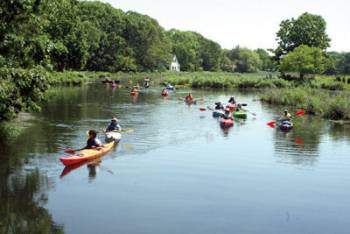 The “ride the tide” contingent, after paddling Mill Cove, arrive at that stretch of Buckeye Brook near the Tidewater Drive Bridge.
The “ride the tide” contingent, after paddling Mill Cove, arrive at that stretch of Buckeye Brook near the Tidewater Drive Bridge.
 The “ride the tide” contingent, after paddling Mill Cove, arrive at that stretch of Buckeye Brook near the Tidewater Drive Bridge.
The “ride the tide” contingent, after paddling Mill Cove, arrive at that stretch of Buckeye Brook near the Tidewater Drive Bridge.
Seventeen kayakers and a single canoeist took to the waters Saturday in a narrated tour and demonstration in support of efforts to preserve Buckeye Brook.
But it’s what’s happening many miles offshore that has Buckeye Brook Coalition president Paul Earnshaw especially concerned.
Earnshaw is encouraged by this year’s buckeye, or herring, count where volunteers recorded 1,700 fish during the spring spawning run to Warwick Pond and that section of the stream flowing into the pond from the north. That number is used to come up with a projected total run.
Last year’s 800 fish count was projected to reflect an actual run of 8,800 fish in what is the state’s only natural uninterrupted herring run. The 2009 run was calculated at 34,000.
Earnshaw fears offshore fishing is unintentionally depleting herring stocks. He said that herring become the “by catch” of other “target” fish such as squid and mackerel.
He said that only makes sense because the herring are the prey of other fish that are being the target of fishermen.
Further, he said that the spring schooling of herring in preparation for their spawning runs make them susceptible to being caught. Commercial fishermen argue that measures to protect predator species such as the stripped bass and dog fish have been so successful that they have resulted in over predation of lobsters, herring and menhaden.
Earnshaw argues commercial fishermen should be required “to leave hot spots” when their by catch of herring reaches certain levels. This is an argument he will make to the Mid Atlantic Fisheries Council and the New England Marine Fisheries Council that sets fishing quotas.
Earnshaw also has a concern for the impact of non-indigenous carp on buckeyes. The carp, which Earnshaw says were introduced from Germany, don’t attack the herring but feast off their eggs. He reported seeing the fish that can grow to 20 pounds and larger swirling in the shallow waters where buckeyes spawn.
“I would like to have a carp tournament,” he said, as people unloaded their boats at Conimicut Point for the annual “run with the tide” paddle up the brook nearly as far as West Shore Road. This would not be a catch and release tournament, however.
Earnshaw also reported the coalition recently received a $5,000 grant from the Warwick Sewer Authority that will be used for the purchase and maintenance of electrical water testing equipment. He explained the funds come from fines levied by the authority for violation of its industrial pretreatment regulations. The authority also uses the money to award scholarships annually to graduating high school seniors.
Earnshaw was especially complementary of sewer authority executive director Janine Burke and the manner in which the authority handled the failure of the Cedar Swamp pump station. The station borders Buckeye Brook and Earnshaw said the coalition was immediately informed of the pump failure and measures were taken to ensure wastewater did not reach the brook.
Earnshaw, however, did not linger too long.
The tide, he noted, would be critical to getting under the Tidewater Drive Bridge. With kayakers and single canoeist, Ken Wilkinson, following, Earnshaw set off for Mill Cove and the mouth to Buckeye Brook. By the time the contingent reached the bridge, the tide had started to ebb but the flow was moderate and there was still room to navigate the bridge by nearly lying flat and pushing off from the underside of the bridge…just as Earnshaw had planned.